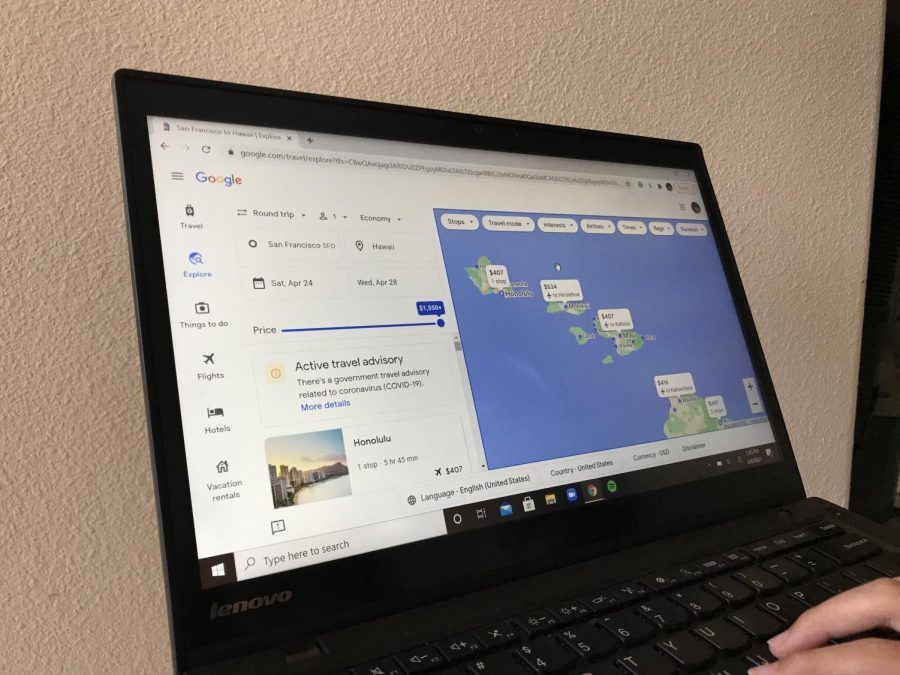Today Hawaii is renowned for its beautiful beaches, massive volcanoes, exotic fruits, and thousand-foot waterfalls cascading off steep mountainsides. Its white-sand beaches and lush flora beckon nearly ten million tourists annually to dip their toes in the year-round swimmable water. But when COVID-19 was on the rise, Hawaii closed up shop.
Hawaii has since been able to reopen to visitors. In Oct. 2020, the mandated 14-day quarantine was replaced with a requirement for a negative test within 72 hours of arrival.
With these lessened restrictions, people began to flood Hawaii for their long-awaited vacations, turning a blind eye to the harm they are causing. Now, with spring break and eager anticipation for summer, Hawaii is facing issues with rising numbers of tourists once again.
“With many tourists refusing to follow simple guidelines or evading the 14-day quarantine required upon arrival in the islands, opening up is proving to be easier said than done,” Gabriella Clark, a local Oahu resident, said.
Even without the disregard for guidelines, there has been a failure to prevent the spread of COVID-19. Even with a negative test, people are still coming into contact with many others while traveling, leaving high chances of contracting COVID-19. Airports are notorious for spreading germs, and Hawaii is no exception.
Cindy Prins is a clinical associate professor of epidemiology at the University of Florida College of Public Health and Health Professions.
“Anything that puts you in contact with more people is going to increase your risk,” Prins said. “If you compare it to just staying at home and quick trips to the grocery store, you’d have to put it above [that level of risk.]”
More than 28,000 people flew through or into Hawaii on March 20, hitting the record for the highest amount in an entire year since the beginning of the pandemic. People have been traveling and tossing aside concerns about the pandemic and how they may be harming the places they visit.
With an influx of tourists, Hawaii is bound to have to handle rising cases, something that’s easier said than done. Hawaii is only equipped with 225 staffed ICU beds, most of which are used for other illnesses. Should more COVID-19 cases arise, hospitals can easily be overwhelmed.
“There’s not much room in the Hawaii health care system for a sudden surge,” Dr. Ryan Roth, a physician in Hawaii, said.
Understandably, locals, particularly Native Hawaiians, have been urging travelers to stay home. They’re no stranger to the harmful effects of epidemics dating back centuries.
“Native Hawaiians have always been silenced or pushed aside in the eyes of both social movement and government policy,” Clark said. “Native Hawaiians make up only a small percentage of the population living in the Hawaiian isles, and they tend to get forgotten when we discuss issues in Hawaii, despite this land originally belonging to them and being unfairly overthrown and annexed.”
Hawaii wasn’t always a US state, as it dates back to a group of Polynesian settlers. By the time the first European set foot in Hawaii in 1778, the Hawaiian population had centuries to establish itself as an independent nation.
Establish itself they did. They crafted an intricate civilization with complex political systems and social systems characterized by dancing and music. Then, in 1810, King Kamehameha even united the Hawaiian Islands under a single monarchy, becoming the first king of Hawai’i.
But by 1820, Christian missionaries brought ships full of cholera, smallpox, and venereal diseases to a vulnerable population. This, coupled with declining birth rates, Native Hawaiians were nearly decimated. To account for the rapid dying off, missionaries attributed it to Hawaiians’ “imprudence and vices.”
By the time Queen Lili’uokalani ascended the throne, she had only a fraction of the power King Kamehameha had experienced. She opposed the Reciprocity Treaty of 1887, which granted the United States Pearl Harbor as a port and commercial concessions.
In response, a coup composed of American sugar planters led by Sanford Dole was staged to dispose of her. She was imprisoned and forced to abdicate her throne when Dole announced the pending annexation by the United States. Bitterly, she fought against it, heading the motto “Hawaii for Hawaiians” under the ‘Onipa’a movement. Still, annexation occurred in July 1898.
A fundamental right is the ability to be self-governing. This right was taken away when Hawaii was overthrown. The US government has since acknowledged their deprivation of Native Hawaiian rights and their lack of direct relinquishment for their sovereignty or land.
Hawaii officially became a state in 1959, but its statehood only perpetuated marginalization. Native Hawaiians remain a victim of exploitation under the guise of tourism. Locals are forced to accommodate visitors from the mainland, impacting not only their day-to-day lives, but also their futures, careers, and land.
Resort developments exploit ancient historical sites and displace Native Hawaiians by forcibly evicting them. They bulldoze temples and fishing shrines, ceremonial platforms, and heiau for resorts, golf courses, and tourist attractions. Toxic fumes pollute rivers and reefs, and crowded beaches threaten coastal fishing. They ignore Hawaii’s indigenous culture in pursuit of creating glossy travel brochures and the perfect experience.
The tourism industry has shifted into becoming Hawaii’s primary economic source, forcing many Hawaiians to choose between playing into the tourism that harms them or struggling needlessly to support themselves.
Tourists in Hawaii experience a false summary of Hawaiian culture, living out polished bits and pieces of the cultural traditions in an Americanized way, thereby disregarding the truth of Hawaiian culture, history, and the difficult realities. Now, with tourism during the pandemic, Hawaiians are even worse off.
Historically, Native Hawaiian and Pacific Islanders not only face systematic oppression but also have limited access to healthcare, poorer health overall, and often live in higher-density housing, all of which make the possibility of COVID-19 outbreaks more devastating. And the spread of COVID-19 is a given, with thousands of tourists pouring in every day.
So, to put it simply, it’s better to wait for an ethical vacation to Hawaii.
“Please have some respect for the people and the island. Hawaii is more than your vacation destination,” Clark said.













